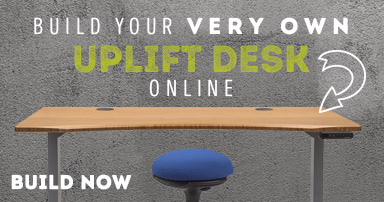Strengthening Your Knowledge About Monitor Arms
Posted by Human Solution on Mar 3rd 2015
As one of the “new guys” on Human Solution team, one of my tasks this week has been to set up my work space and workstation. Part of that process was finding a monitor arm for the monitors I would be using. In doing so, I learned that an ergonomic workstation is made up of properly selected parts, all working in unison to create the most comfortable solution for an individual. I also quickly discovered that our website provides a number of resources and tools to help determine the best fit for a person and the correct products for their work space. It was a great learning opportunity for me, and I’d like to share some of that information, as it would be beneficial to anyone looking to purchase a monitor arm.
A monitor arm’s most basic function is to support a computer monitor: a product that can differ significantly from one model to another. Two of the main differences between monitor displays are weight and mounting compatibility, and these two factors play a large part in finding the right arm to buy. Therefore, it will be very helpful to know the weight of your monitor and how it’s mounted when shopping for monitor arms.
The weight of a monitor can be found on its product specifications page (either on the product page online or in the supporting documentation usually packaged with electronics). Since monitors can easily range in weight from 7 lbs for a 20” LED to 40 lbs for a large LCD display, it’s essential that you know the weight of your monitor. This is the only way to be certain you’re getting the arm you need. Different monitor arms have different weight capacities, so staying well within those capacities guarantees that an arm is performing correctly, and that its mobility and adjust-ability are not impeded by a monitor that’s too heavy. The image below shows the specifications box from an UPLIFT Monitor Arm product page, where the Weight Capacity is clearly noted.
The image also shows the Monitor Compatibility of the UPLIFT Monitor Arm. This information refers to the and signifies whether it’s compatible with the monitor being used. Most monitor arms sold now are VESA compliant, and use standardized mounting plates in either 75mm x 75mm or 100mm x 100mm sizes. 200x100mm plates are also used by some monitors, but are less common. A notable exception worth mentioning, that doesn’t adhere to VESA standards, is Apple. Its products require a special VESA adapter that’s only available from the Apple store.
For customers not using Apple products, but still needing a monitor arm that isn’t VESA compliant, the Workrite Non-VESA Mount works with a wide range of monitors, but does add 4.5 lbs. to the total weight of the display. A slimmer option would be the ESI Encloze Non-VESA Monitor Conversion Bracket , which works for smaller, lighter displays. In both cases, the additional weight of the adapter must be added to the overall weight when checking the weight capacity of a monitor arm.
I hope this information is helpful during your purchasing experience. As always, we’re happy to assist you further, or to answer questions you may have. Just give us a call or stop by our Austin location. You can just let us know your monitor's model number and we'll do the work of figuring out the monitor arms with which it will work!
Learn more about monitor arms and other ergonomic accessories at TheHumanSolution.com!
Related Reads:




